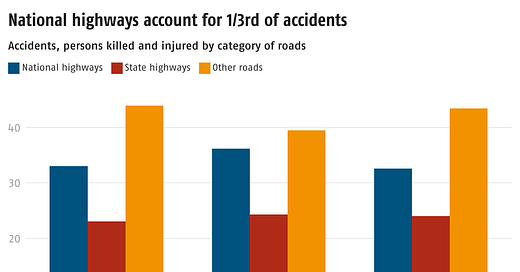Not just potholes: The reasons Indian roads are unsafe
Spending on safety is inadequate as accidents and fatalities continue
India this week got an international award for road safety but data shows it has miles to go. More than 1.5 million people died in road accidents over the past decade in the country, exposing weakness in enforcing rules, infrastructure and public awareness. In 2023 alone, 170,000 people died in road accidents: That amounts to 474 fatalities daily on average, or one every three minutes.
Data from the Ministry of Road Transport and Highways and independent research by Acko, a digital insurance provider, shows the severity of the crisis. Acko found that major cities like Delhi, Mumbai and Bengaluru comprise a large portion of accidents in the country due to the sheer number of vehicles, poor road planning and weak enforcement of traffic laws. Its research shows that stray cattle are a major cause of accidents, particularly on highways and rural roads.
Although national highways form just 2 per cent of India’s total road network, a disproportionate share of accidents and deaths happen there. Such highways account for 33 per cent of total accidents and 36.2 per cent of fatalities. State highways, which span a larger portion of the network, are where 23.1 per cent of accidents and 24.3 per cent of fatalities happen (chart 1, click image for interactive link).
Going by traffic rule violations, over-speeding is to blame for 72.3 per cent of accidents and 71.2 per cent of fatalities. Other major damaging violations include motorists driving on the wrong side of the road (4.9 per cent of accidents; 5.4 per cent of fatalities) and using phones while driving (1.6 per cent; 2 per cent) according to a report by the roads ministry (chart 2).
Road design and infrastructure ensure safety. Straight roads account for 67 per cent of accidents and 66.4 per cent of fatalities, likely due to over speeding and shoddy road discipline. As many as 11.8 per cent of accidents and 12.2 per cent of fatalities happen on curved roads, while bridges, culverts and steep gradients add to risks. Construction zones are another hazard – places where 2 per cent of accidents and 2.4 per cent of fatalities occur. Potholes – an everyday sight on Indian roads – account for a relatively small percentage of accidents but they are deadly. Between 2021 and 2022, potholes were blamed for the highest percentage increase in fatalities in all road-related vehicle crashes.
The roads ministry allocates less than 1 per cent of its budget for road safety measures. In 2019-20, only 0.14 per cent of the budget was spent on safety. The amount increased to 0.21 per cent in 2020-21 before dropping to 0.13 per cent in 2021-22, the lowest in recent years. There was a marginal increase in subsequent years and projections show spending will rise to 0.32 per cent in 2025-26 but the funding is grossly inadequate. In contrast, the United States invests approximately $3.1 billion in its Highway Safety Improvement Program, amounting to about 6 per cent of its total highway expenditure (chart 3).
India had the highest number of road accident fatalities in 2022, with 131,714 deaths, according to the World Road Statistics published by the International Road Federation. China ranked second with 61,703 deaths, followed by the United States in third place with 38,824 deaths.





